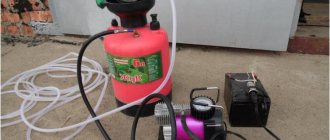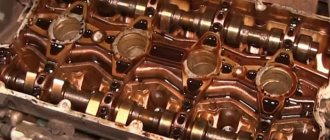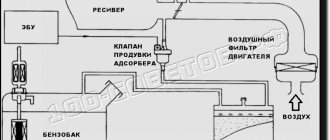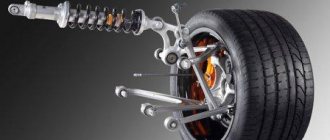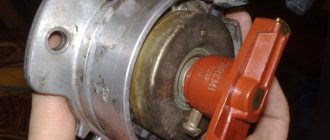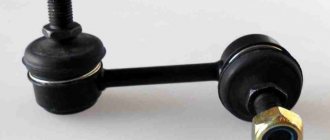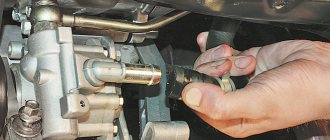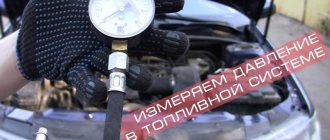The vast majority of modern cars are equipped with fuel injection systems. There are modifications in which gasoline is sprayed by a nozzle in the intake manifold. There are also models in which fuel is sprayed directly into the engine cylinders.
Diesel units operate differently than gasoline internal combustion engines. In them, diesel is supplied to an already compressed environment in the cylinder. In order for a portion of fuel to be sprayed smoothly, a mechanism such as a high-pressure fuel pump is needed.
Let's consider the features of such a mechanism, its modifications and signs of malfunction.
What is a fuel injection pump and why is it needed?
The mechanism, which is abbreviated as injection pump, is part of the fuel system of a diesel engine, but there are also models for gasoline power units. The only difference between the fuel pump of a diesel engine is that the pressure it generates is much higher than its gasoline counterpart. The reason for this is the fundamental features of the unit’s operation. In the cylinders of a diesel engine, the air is first compressed to such an extent that it is heated to the ignition temperature of the fuel.
When the piston reaches top dead center, the injector sprays fuel and it ignites. The injector needs to overcome enormous pressure. For the system to work properly, the pump must create more pressure than in the cylinders.
In addition to the mentioned function, the pump must also supply fuel in portions, depending on the operating mode of the power unit. This parameter is determined taking into account the rotation of the crankshaft. In a modern car, this process is controlled by an electronic control unit.
Plunger pair design
The plunger pair consists of a plunger 9 and a sleeve 8. The sleeve has one or two inlet channels (with two channels, one of them serves as inlet and bypass), which connect the suction cavity to the high-pressure chamber of the plunger pair. Above the plunger pair there is a fitting 5 with a landing cone 7 of the discharge valve. The rack 10 moving in the injection pump housing rotates the gear sector 2, thereby controlling the adjusting sleeve 3 of the plunger. The movement of the rack itself is determined by the crankshaft speed controller. This allows you to accurately dose the cyclic feed amount. The full stroke of the plunger is unchanged. The active stroke and the associated cyclic feed value can be changed by turning the plunger, which is done using an adjusting sleeve.
- Suction cavity
- Gear sector
- Plunger adjusting sleeve
- Side cover
- Discharge valve connection
- Discharge valve body
- Discharge valve cone
- Plunger sleeve
- Plunger
- Injection pump rack
- Plunger driver
- Plunger return spring
- Lower return spring plate
- Adjustment screw
- Roller pusher
- Injection pump cam shaft
In addition to the longitudinal groove 2, the plunger also has a spiral groove 7. The resulting oblique edge on the surface of the plunger is called a regulating edge 6. If the injection pressure does not exceed 600 bar, then one regulating edge is sufficient; for higher injection pressures, a plunger with two regulating edges milled on opposite sides of the plunger. Their presence reduces the wear of the plunger pair, since the plunger with one control edge is pressed under pressure against one side of the sleeve, increasing its production. The plunger sleeve has one or two holes for supplying and returning fuel. The plunger is ground into the sleeve so tightly that the pair is sealed without additional seals, even at very high pressures and low crankshaft speeds. Because of this, only complete plunger pairs can be replaced. The amount of possible fuel supply depends on the working volume of the pair. The maximum injection pressure at the nozzle can be, depending on the design, 400... 1350 bar. The angular shift of the cams on the cam shaft ensures precise alignment of injection with the phase shift of processes along the engine cylinders in accordance with the order of its operation.
a - sleeve with one supply channel b - sleeve with two supply channels
- Supply channel
- Longitudinal groove
- Plunger sleeve
- Plunger
- Bypass channel
- Regulating edge
- Spiral groove
- Annular groove for lubrication
PLUNGER PAIR WITH DRIVE
a — BDC of the plunger b — TDC of the plunger
- Cam
- Video clip
- Roller pusher
- Lower return spring plate
- Plunger return spring
- Upper return spring plate
- Plunger adjusting sleeve
- Plunger
- plunger sleeve
History of development and improvement
This device was first developed in the 1930s by Robert Bosch. In passenger cars, injection pumps began to be actively used in the second half of the same decade.
Since the first gasoline engines were equipped with carburetors, only diesel units needed such a mechanism. Nowadays, gasoline engines with a direct injection system also have a pump of this type (a carburetor is already extremely rare - only in older generation cars).
Although the operating principle of the pump has remained virtually unchanged, the mechanism itself has undergone multiple modernizations and improvements. The reason for this is the increase in environmental standards and performance of internal combustion engines. At first, a mechanical injection pump was used, but it was not economical, which led to large emissions of harmful substances. Modern electronic pumps show excellent efficiency, which allows transport to fit within environmental standards and satisfy drivers of modest means.
High pressure pump design
There is a wide variety of modifications of fuel injection pumps for gasoline engines, as well as diesel analogues. However, in most cases, the main elements of a mechanical pump are:
- A filter is installed at the inlet in front of the pump;
- A plunger piston located in a cylinder - the so-called. plunger pair;
- A housing in which recesses are made - fuel is supplied through them to the plunger pair;
- Shaft with cam and centrifugal clutch. This element is connected to the timing pulley using a belt drive;
- Plunger pair drive pushers;
- Springs that return the plunger piston back;
- Supercharger valves;
- Mode regulator – connected to the gas pedal;
- Injection pump return valve (through it, excess fuel is supplied to the return);
- Low pressure pump (pumps fuel into the pump).

